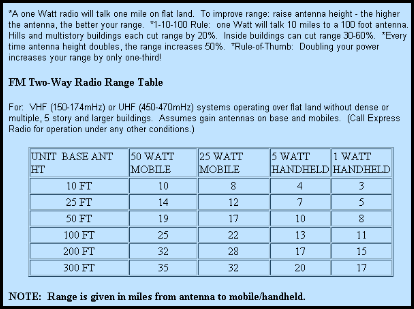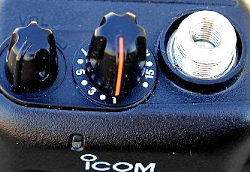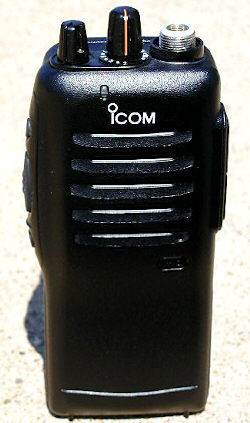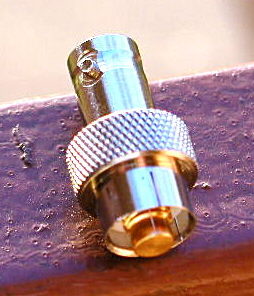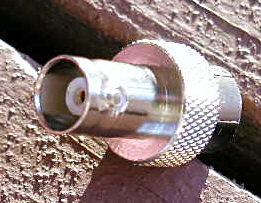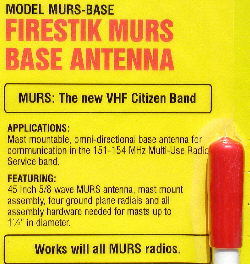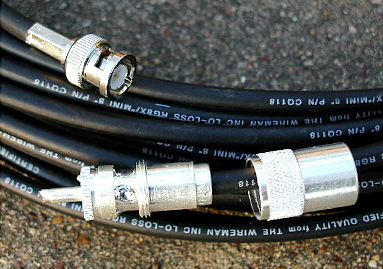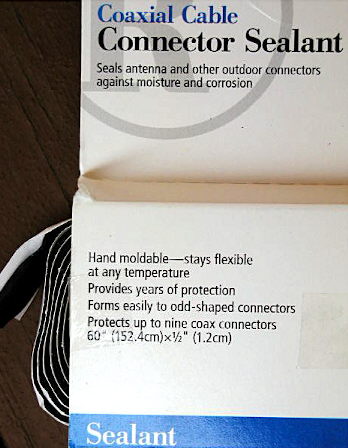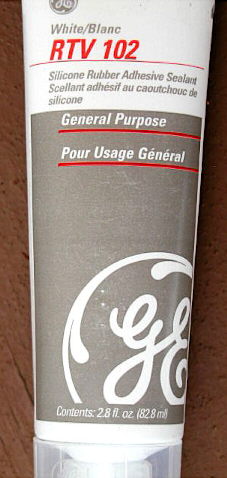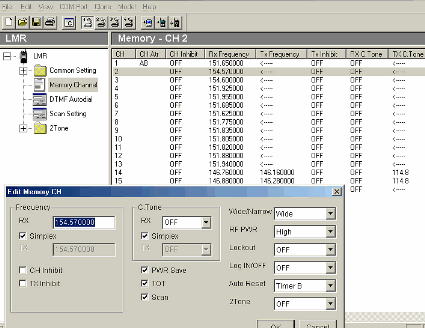| A MURS VHF Setup that Works Good |
| This setup will work out to several miles |
| Multi Use Radio Service (MURS) | ||||
|
||||
| The ICOM F11 | |||||
There
are many different manufacturers or radios. The particular type of radio
we will be talking about is called a Portable or Handheld type radio such
as the Icom F11 show here (without the antenna) in FIG
2 and 3. These radios are typically 1, 2 or 5 watt (transmit
power) units. There are also Mobile or Base station radios which are typically
35 to 70 watt radios. The typical receive sensitivity is about .25uV/12dB
SINAD which is good, but just slightly less sensitive than a good ham
radio operating in the same frequency band. The several manufacturer's
of radios that come to mind are Motorola, Maxon, Standard, Tekk, Kenwood,
Vertex, Icom and several others. I decided on an Icom radio because of
the price and the quality. Also I worked at Icom America as a radio technician
from 1998 to 2000, and I know that Icom makes good gear. Motorola is probably
the most popular name though, but their radios are expensive. The Icom
F-11 is a 5 watt unit and it comes with a charger, battery, antenna, and
belt clip for $186.00. I bought my radios from Action
Communications in Tucson, AZ. They have a good price and good customer
service. They will also program the radio for you. You certainly want to
have the 5 MURS frequencies programmed into the radio. Also the Icom F11BR
is similar to the Icom F11 except that it is a 2 watt radio. Remember
the legal limit of power for MURS is 2 watts. The Icom F11 is more versatile
than the F11BR and output power on the F11 is selectable as 1 watt, 2
watts or 5 watts. The F11BR is also a 2-channel radio where the F11 is
a 16 channel radio. With the F11BR you have your choice of programming
2 of several channels available, but you can only use 2 at a time. Here
is the download link at Icom America for the Icom
F11BR. The cost of the F11BR is about 161.00 from Action Communications
and includes the battery, belt clip, antenna and charger. The Icom .pdf
file will list the available frequencies you can program into the radio.
Some of them are for the licensed business band. I'll talk more about
programming later on.
You need to decide which brand of radio is right is right for you. Most of us go with what we have a good track record with. Although I recently bought a pair of Tekk NT-8's for $49 a pop at Fry's Electronics in Dallas. These radios work good, and the price was just too good to pass up. Whatever radio you choose, it may have one of several different types of antenna connectors. You will need to know this info if your going to order an after market antenna that will provide additional gain for your radio. I'll talk about some after market antennas later on. BTW, here is the link for the .PDF file on the Icom F11. |
|
||||
| ICOM Adapters | |||||
The
Icom F11 and F11BR and F11S all have Motorola MX type threads. There are
several manufacturers of antennas that have the MX male thread to fit
the MX female thread on the F11. Of course the rubber duck antenna that
comes with the F11 has a MX male thread. However, if you want to use an
outdoor antenna with your radio you will have to run coax between the
radio and the outdoor antenna. Also unlike the portable antennas for the
radio, coax has an outer shield that must be connected to the outer threads
as well as the coax center conductor connected to the inner threads. Icom
has an adapter for this called the AD98-FSC (See
FIG 4 and 5). This has MX threads that screw down into the
center MX female thread on the radio and then it makes a press fit with the
he outer threads. The other end of the connector is a BNC female thread
that will connect to a BNC male connector on the coax line. I searched
several sources for a different type of adapter that also had threads
on the outside, but I don't believe there is such a connector. It would
have to have an independent outer ring so that the threads on the outer
ring could be started independently of the threads on the inside. I anybody
knows of such a connector, please contact me and let me know. The AD98-FSC
screws very tightly down into the radio threads and you really have to
twist hard to get it to seat all the way down. It forms a very tight press
fit against the outer threads of the MX connector on the radio. Of course
if you buy a radio that already has a BNC female connector, you wont need
to buy an adapter. The disadvantage of a radio with a BNC antenna connector
is that the antenna tends to fit sloppy on the connector and will wobble
back and forth and put stress on the connector. A MX or other type connector
on the radio will make for a much tighter mechanical link with the he antenna.
These adapters are available from any dealer that carries Icom portables. |
|
||||
| Better Antennas for Handhelds | ||||
There are several different manufacturers of antennas that can be added to the handheld unit that will improve the range and/or Signal to noise ratio of your radio link. Adding a better antenna on the handheld will not improve the link like putting up a good outdoor antenna at your base station, but there is a noticeable difference. The standard antenna that comes with most handhelds is the Rubber Duck antenna in the picture on the right (FIG 6). This is the antenna that Icom sends with the handheld. Notice it is short and has a "Motorola MX" type connector at the bottom. These rubber duck antennas are not true 1/4 wave or 1/2 wave antennas and a true 1/4 wave or 1/2 wave antenna may have 3 to 5 dB of gain over them. Remember a 3 dB gain makes the transmit power appear to be twice as strong. A 6 dB gain makes the transmit power appear to be 4 times as strong. Don't worry about getting a better antenna for your handheld to get started with MURS. You may find the better antennas for your handheld too long and clumsy to work with. Concentrate your effort on getting a good outdoor antenna setup at where ever you're going to use your hand held as your base station radio.
The Smiley 5/8 Slim Duck which is a 1/4 wave antenna (FIG 7) works well though, and it is a fixed length unlike the telescoping antennas. It is 10 inches long, and can't be folded down. The advantage of having a telescoping antenna is that you can fold it down when carrying it on your belt and the antenna wont hit you in the side or under the arm. The Smiley 5/8 Slim Duck (which has a resonant center frequency of 155MHz) came in 2nd on my test of 4 different antennas for the F11 handheld. I'll talk more about this range test in the next section. |
||||
| More Antennas for Handhelds | ||||
The Antenna on the right (FIG 8) is made by a company called Smiley Antenna. This antenna is a telescoping 5/8 wave antenna that is base loaded with a spring that also serves as the support for the telescoping part. This antenna is a 1/4 wave antenna when folded down and a 5/8 wave antenna when telescoped all the way out. When I tested this antenna (just by doing Forward/Reflected test with a Bird watt meter, I found it to be resonant at the MURS frequencies, but a little too long when telescoped out. It was really seems to be more resonant in the ham band (144 to 148MHz) when telescoped out. Of course you could get around this problem by shortening the antenna. Also, with the exception of the Smiley Superstick II, telescoping antennas need to be extended before you can use them to transmit or the VSWR will be off the charts. They can receive without being telescoped out. The Smiley Super Stick II is really too much antenna for a little handheld. Imagine a radio only 6 or 7 inches tall with a 54" antenna! The Smiley Superstick II came in 3rd on a range test of 4 antennas that I conducted with ham radio operators 4 and 5 miles away. They said it didn't matter if the antenna was extended in the 5/8 wave position or retracted in the 1/4 wave position--the signal strength was the same.
The antenna on the left (FIG 9) is made by Antenex. It is a telescoping antenna that is supposed to have a center frequency of 150MHz. This antenna was the winner in my signal strength contest with the ham radio operators communicating on 154.570MHz. In fact they said this antenna was clearly the strongest one of the bunch. I was surprised by that because I didn't think this antenna was really cut for a center frequency of 150MHz, but it seemed to be more resonant in the lower ham band (142MHz) to me. Ideally we want an antenna with a center frequency of 153.200MHz. But the proof is in the taste of the pudding as they say. Antenex claims this is a 1/4 wave antenna, but I have my doubts about that. The antenna is 21 inches long when telescoped out. And BTW, this antenna MUST be used in the fully extended position when transmitting. I also tested it with the antenna down with my ham radio friends, and they said the signal was way down so it is only resonant when fully extended. Like all telescoping antennas you can receive just fine, but it must be extended to transmit. If you don't extend it your signal strength will be weak, and the reflected power on the output transistors will be hard possibly causing the transmit final to fail. But this antenna is only 7 & 1/4 inches long when telescoped down which makes it real convenient to carry around with a belt clip. The Icom rubber duck antenna is an inch shorter at 6 & 1/4 inches. The only disadvantage to this antenna is that the telescope part must be extended to transmit. Antenex claims that this is a 1/4 wave antenna, but since radio waves travel at approximately 982,000,000 feet/second and the operating frequency is 154.570MHz, this means a full wavelength is 76 inches. If we divide that by 4 we get 19 inches which is slightly less. The engineers may have figured in a velocity factor of .98 or .95 for the antenna material which would reduce the length to somewhere between 17 and 18 inches. The thing is though this antenna obviously has a spring for the base, and usually the spring is used as a helical base loading coil which adds a lot more length to the antenna. For that reason I'm guessing this is a 1/2 wave antenna, but I don't know for sure. This antenna might even be a 3/8 wave antenna, but it is certainly longer than 1/4 wave. The Smiley Slim Duck is a true 1/4 wave base loaded antenna, and it is only 10 inches long. The coil at the base of the Antenex DTS150MX is even larger than the coil of the slim duck. Both antennas are compact though. So the Antenex DTS150MX and the Smiley 5/8 (1/4 wave) Slim Duck are my recommendations for the best antennas. The order number for the Smiley Slim Duck is 15523. There are other manufacturers that may have good antennas (probably in a fixed antenna and not a telescoping antenna) such as Larsen and Comet, but I did not test those. |
||||
| Base Station Antennas | ||||||
The outdoor antenna or base station antenna (FIG 10) is probably the most important part of good MURS operation. This antenna here is made by Firestik and has a center frequency of 153.210MHz which is right in the middle of the 2 MURS bands. The antenna has to be assembled, but installation is easy. The antenna is rugged and made to last. The actually antenna element is a piece of wire going in a slight helical wrap of 3 turns around the outside of the antenna. Three turns equals approximately 4.5 more inches of length. So the total length of the wire is 48 inches. Use the formula for determining a full wave antenna we take the speed of light (982,000,000 feet/sec) and divide this by our operating center frequency which is 153,210,000 and the result is 6.41 feet or 76.5 inches for a full wave. Firestik says the antenna is 5/8 wave and 5/8ths of 76.5 inches is almost exactly 48 inches which is the length I measured for the antenna. So while I am not going to take this out of the box and do a VSWR test on it, at least in theory the length if correct. The velocity factor of the light through a bare wire should be well above 99% so we should not have to take that into our calculations. I like it when these folks at least have the lengths right in theory. I've seen some antennas advertised at 5/8 wave at 150 or 155MHz and then I do the math and it just doesn't seem right. For instance Smiley advertised their 5/8ths wave Slim Duck for 155MHz as having a length of 54 inches. And in fact it does have a length of nearly 54 inches. This is why I had to push the telescope down about 5 or 6 inches at work to get the best forward to reflected power measurements on the Bird watt meter.
Probably the toughest part of your set up will be installing this antenna (or another similar antenna) on top of your roof or shop. I'm going to leave it up to your imagination and your own research to determine the best way to mount it as every situation is different. If you buy a tripod type TV roof mount you have the issue of going through and water proofing the shingles. You can buy brackets (probably from a local TV shop) that mount on the side of the house and hold the mast. This antenna is slightly heavier (about 3 or 4 lbs) than a TV antenna and you should use a good solid mast. A good strong TV mast should work fine and the antenna should be mounted at the very top of the mast. You could even add it to the very top of an existing TV mast if the antenna is mounted at the very top of the mast. You will want to let secure the coax to the mast and also make sure there is a loop is some slack in the coax before it goes into the building. This will help keep water from running down the coax and running in a direction into the house. There are different methods of feeding the coax through brick, wood siding, etc. and water proofing the feedthru. You can research this on the net or consult a local TV shop. Try to mount the antenna as high up as practical--even on a 10 foot mast if possible. You could even mount it on a tower if you have an existing tower. There are other manufacturers of MURS base station antennas, but the ones I found were really made for police repeaters either in the 155MHz or 151MHz band. These antennas were capable of handling up to 800 watts and they were rather expensive--generally 300 to 800 dollars or more. One such manufacturer is Hustler which is right here in Mineral Wells, TX. Decibel Antennas also makes antennas in this frequency band, but they are mostly designed for high power commercial use. As the site of this antenna will be 300 miles away near Hot Springs, AR, I am not going to assemble it and do a VSWR test on it. I am only going on the reputation of this company, but I know it should still be checked to see if it really does have a center frequency of 153.210MHz. Just the fact that they cared enough to make an antenna claiming a center frequency of 153.210MHz (which is right in the middle of the MURS bands) tells me that this antenna probably is resonant on those frequencies with no more than a 1.5 VSWR on any band. I'll report back the results of the installation and how well it performs when it is all set up. When using an outdoor antenna at my place of employment (which is completely enclosed by metal--even on the roof) it improved range from half a mile to exactly 2 miles. And note that I was using an outdoor antenna in the aircraft band (118 to 137MHz) for the base antenna that was up about 25 feet. This means that my VSWR was almost off the charts. I was using 5 watts to transmit, but probably 4 was being reflected back for a total of just one watt transmit power. The antenna on the Icom F11 was the Smiley Superstick II which performed almost as bad as the rubber duck that came with the antenna. Still communication improved to 2 miles. With a base station antenna that is resonant and with a better antenna for the handheld such as the Smiley Slim Duck or the Antenex DTS150MX, I surely expect communications to be good to at least 3 miles even through the roughest type of terrain or hills and buildings. With real good conditions perhaps links would be good up to 5 or 6 miles. BTW, the link test at my place of employment was through lots of trees too, but remember this was from inside a metal building. If your going to just use it in a brick, wood or glass building, (or even outdoors) I would expect communications to at least 2 miles or more when using the Antenex or Smiley Slim Duck on the Icom F11. I will conduct a test like this and report back the results. Remember I said I did the radio test with my ham radio operator friends that were at least 4 miles away. They reported "full scale" with no static receive signal when using the Smiley Slim Duck antenna or the Antenex antenna on the F11. They were using amateur radio 2 meter mobile units with good receivers and their transmit power was reduced to 2 watts to make it legal in the MURS bands. But remember they had very good outdoor antennas. One guy has an outdoor antenna on a 100 foot tower and the other fellow had a 30 foot vertical for 2 meter and HF ham use. Still the link was from the balcony of my apartment, through lots of tress, over a hill about 300 feet high and down the back side of the hill to their locations between 4 and 5 miles away. Not bad! And this is why I have confidence that once this system is setup the results will be very satisfactory. |
||||||
| Drawing of Firestik MURS Base Station Antenna Assembled |
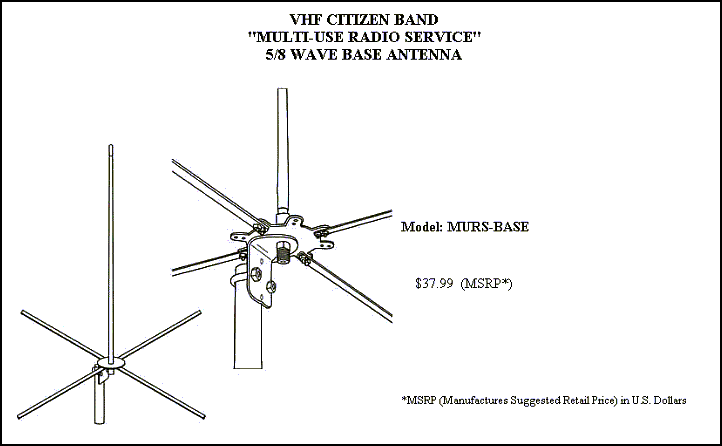 |
| Coax and Connectors | ||
You must use coax between the base radio and the outdoor antenna. You could go to radio shack and buy RG-58, but it has about 6dB of loss/100 feet which means a 5 watt signal would be 1.25 watts when it got to the antenna--if you used 100 feet of coax. The type of coax (FIG 12) I bought from The Wireman is a special low loss coax called RG8X or mini 8 low-loss. It only has 3.5dB of loss/100 feet which means my 70 foot section will only drop the signal down to about 3.5 watts at the antenna. That is 3.5 watts if I had the radio set for 5 watts transmit power, but I would never do that would I? The legal limit of power for MURS is 2 watts out of the transmitter. Of course the shorter the run of coax the better. Try to keep the run short. 70 feet is pretty long, but not unworkable. The higher you go in frequency the more loss coax has. Another real good thing about The Wireman is that he will custom make your cable for your for a very reasonable price. You could not buy RG-58 at Radio Shack (and the connectors) and make the cable any cheaper than you could if The Wireman did it for you. And the cable will be much better (actually RG8X is a little bigger than RG-58) and you will have a true pro doing the job for you. The coax part number is CQ118. I also found a couple of other sites that said they would custom make coax cables. I only tried the Wireman first because I have seen him at ham radio shows over the past 15 years. The product, service and price were excellent.
Notice that on one end of the cable is a PL-259 connector (with the sleeve) that will attach to your outdoor antenna. On the other end of the coax line is a male BNC connector that will easily attach to the Icom radio using the AD-98FSC MX to BNC female connector. Don't skimp on this part of the job. A list of The Wireman's coax and prices are at the end of this page. The 70 foot cable with the connectors and including labor was only about $45.00 which is a bargain considering the quality! Here is a list of some of The Wireman's coax cables. Notice especially the column that list the amount of loss (in dB) at 150MHz which is the frequency we operate near. Notice that it is significantly more than operating at 30MHz or in the ham radio bands. This is why it is important to use low loss coax. RG8 and variants there of are actully better cable to use than the mimi 8 or RG8X that I used for this installation, but RG8 is a heavy line and about 3 times the size of mini 8. However, if you anticipate that you would ever upgrade to a base station type radio, then you may just want to go ahead and order a good length of RG8 coax for your setup. Still you can use RG8X with 100 watts easily and you can get an adapter to go from your SO-239 connector on a base station radio to your BNC male connector. I'll talk more about upgrading at the very end of this page.
|
||
| Coax Connector Sealers and Waterproofing | |||||
It's essential to get a good water tight seal between the coax line and the antenna. The PL-259 makes for a pretty mechanical connection, however as with most CB type antennas the SO-239 is flat on its base instead of notched. Notice that the PL-259 on the coax has 2 small notches which would normally mate with the notched SO-239 connector. These 2 small notches are going to cause the outer part of the connector to not completely butt up agains the SO-239 connector on the antenna. If you want you can file them both down between mathing the 2, but be careful not to twist the coax when installing the outer right.
There are several different methods of making a good water tight seal. You can start by using electrical tape and getting a good tight seal, and then applying a type of coax seal like the Radio Shack stuff (FIG 13) I have here in the picture. Then I would cover the whole thing with GE silicon (FIG 14) which I believe is more water and moisture proof than other types of silicon. Another very good sealer is something called ScotchKote which is made by 3M. It is available at electrical supply distributors. I read on an internet bulletin board where some guy said that in the hot Texas sun this compound breaks down if placed over electrical tape. You may want to first apply some coax tape to the joint and then coat it with Scotchkote and then coat it with coax tape again. I have used Scotchkote on board ships and it is absolutely water and moisture proof even when exposed to hot temperatures and sea water. Another product that is similar to the coax tape I bought from Radio Shack is something called Coax Seal. This is real popular with the amateur radio operators and works well. You can lay down the electrical tape and then use the Coax Seal over it--or just use the coax Seal tape. It seems to work well, and it also seems to be the same stuff that is in the Radio Shack box, but I don't know for sure. After you apply the coax tape, you can also use a good quality silicon sealer like the GE type. I would not rely only on Silicon to Seal the connector though as it will not be completely air tight. You should first use ScotchKote or Coax Seal and then apply a good layer of the GE silicon over the entire area joint. |
|
||||
| Icom CS-F11 Programming Software | ||||
|
||||
| Move to a Licensed Band & Use All Your MURS Equipment |
The other option when moving to a licensed band is just simply to change to one of the existing business band frequencies already programmed into the radio and set the radio for 5 watts of power--it's that simple! You will be operating on your own assigned frequency that should have less traffic on it than any of the other 5 MURS frequencies. Although I still haven't heard of overcrowding on the MURS frequencies yet, this may be the case in large urban areas--but I haven't heard anyone complain about it yet. One of the advantages of getting a license though is that you can transmit up to at least 35 watts--I'm not exactly sure what the legal limit of power is. The base station can transmit at this power and also the mobile units in vehicles and also handheld units although handheld units are usually limited to 5 watts output power. If your going to get a license you might as well take advantage of the power increases that come with having a license. I have heard the fee is anywhere between $40 and $120 dollars, but I don't know exactly what it is as I have not researched this area of operation. The license is good for 10 years just like a ham radio license.
Well, enjoy your VHF comms. I think it's a good band to operate on.
Craig / Mineral Wells, TX / 3-27-04
Here's an update on 12/2011. I received an email from a fellow at Firestik Antenna the other day, and he said that a lot of hunters and hikers are going back to using CB radio in the 26MHz band. If you need to communicate more than 5 or 6 miles, this is probably the best way to go. Still, you will need a good base station antenna up as high as possible to get good range. He said FRS radio has lost popularity, and most people just don't know about MURS. There still isn't much in the way of base station radios for MURS or MURS specific radios. MURS is really good comms though for say less than 6 or 7 miles. It is FM modulation which is clearer than the AM modulation that CB uses. But, you will find a lot of equipment in the CB line--just stay off those frequencies the truck drivers are using. I still think MURS is a good mode and frequency band to work on. The firestik guy said in the past few years they have sold 200 MURS antennas.
Western Union |
